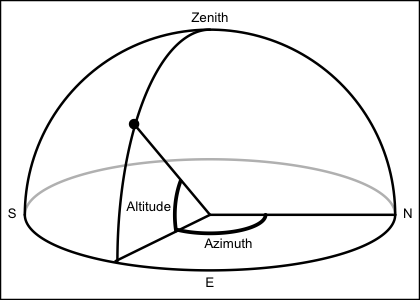This calculates solar angle, based on a NASA-provided Fortran
program, which (according to comments in the code) is in turn
based on "The Astronomical Almanac".
Note that time may be a single value or a vector
of values; in the latter case, longitude, latitude and useRefraction
are all made to be of the same length as time, by calling rep(). This
addresses the case of finding a time-series of angles at a given spatial
location. For other cases of arguments that are not single values,
either call sunAngle() repeatedly or, if that is too slow,
use expand.grid() to set up values of uniform length that
are then supplied to sunAngle().
Arguments
- t
time, either a POSIXt object (converted to timezone
"UTC", if it is not already in that timezone), or a value (character or numeric) that can be converted to a time withas.POSIXct(), assuming the timezone to be"UTC".- longitude
observer longitude in degrees east.
- latitude
observer latitude in degrees north.
- useRefraction
boolean, set to
TRUEto apply a correction for atmospheric refraction.
Value
A list containing the following:
timethe timeazimuth, in degrees eastward of north, from 0 to 360.altitude, in degrees above the horizon, ranging from -90 to 90.diameter, solar diameter, in degrees.distanceto sun, in astronomical units.declinationangle in degrees, computed withsunDeclinationRightAscension().rightAscensionangle in degrees, computed withsunDeclinationRightAscension().
References
Regarding declination and rightAscension, see
references in the documentation for sunDeclinationRightAscension().
The other items are based on Fortran code retrieved from
the file sunae.f, downloaded from the ftp site
climate1.gsfc.nasa.gov/wiscombe/Solar_Rad/SunAngles
on 2009-11-1. Comments in that code list as references:
Michalsky, J., 1988: The Astronomical Almanac's algorithm for approximate solar position (1950-2050), Solar Energy 40, 227-235
The Astronomical Almanac, U.S. Gov't Printing Office, Washington, D.C. (published every year).
The code comments suggest that the appendix in Michalsky (1988) contains errors, and declares the use of the following formulae in the 1995 version the Almanac:
p. A12: approximation to sunrise/set times
p. B61: solar altitude (AKA elevation) and azimuth
p. B62: refraction correction
p. C24: mean longitude, mean anomaly, ecliptic longitude, obliquity of ecliptic, right ascension, declination, Earth-Sun distance, angular diameter of Sun
p. L2: Greenwich mean sidereal time (ignoring T^2, T^3 terms)
The code lists authors as Dr. Joe Michalsky and Dr. Lee Harrison (State University of New York), with modifications by Dr. Warren Wiscombe (NASA Goddard Space Flight Center).
See also
The corresponding function for the moon is moonAngle().
Other things related to astronomy:
angle2hms(),
eclipticalToEquatorial(),
equatorialToLocalHorizontal(),
julianCenturyAnomaly(),
julianDay(),
moonAngle(),
siderealTime(),
sunDeclinationRightAscension()
Examples
rise <- as.POSIXct("2011-03-03 06:49:00", tz = "UTC") + 4 * 3600
set <- as.POSIXct("2011-03-03 18:04:00", tz = "UTC") + 4 * 3600
mismatch <- function(lonlat) {
sunAngle(rise, lonlat[1], lonlat[2])$altitude^2 + sunAngle(set, lonlat[1], lonlat[2])$altitude^2
}
result <- optim(c(1, 1), mismatch)
lonHfx <- (-63.55274)
latHfx <- 44.65
dist <- geodDist(result$par[1], result$par[2], lonHfx, latHfx)
cat(sprintf(
"Infer Halifax latitude %.2f and longitude %.2f; distance mismatch %.0f km",
result$par[2], result$par[1], dist
))
#> Infer Halifax latitude 39.44 and longitude -63.56; distance mismatch 579 km